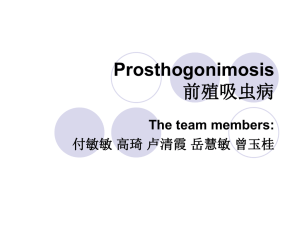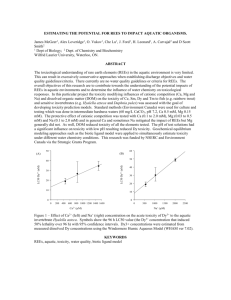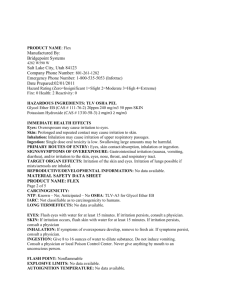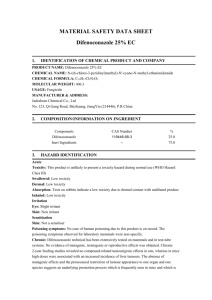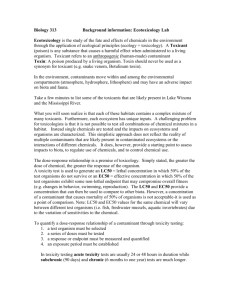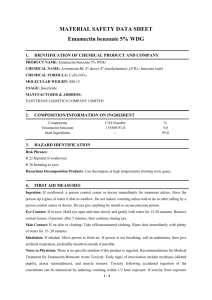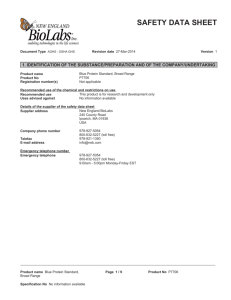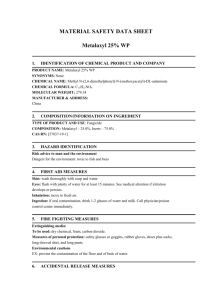Larvicidal activity of Azadirachtin against Fasciola larvae
advertisement
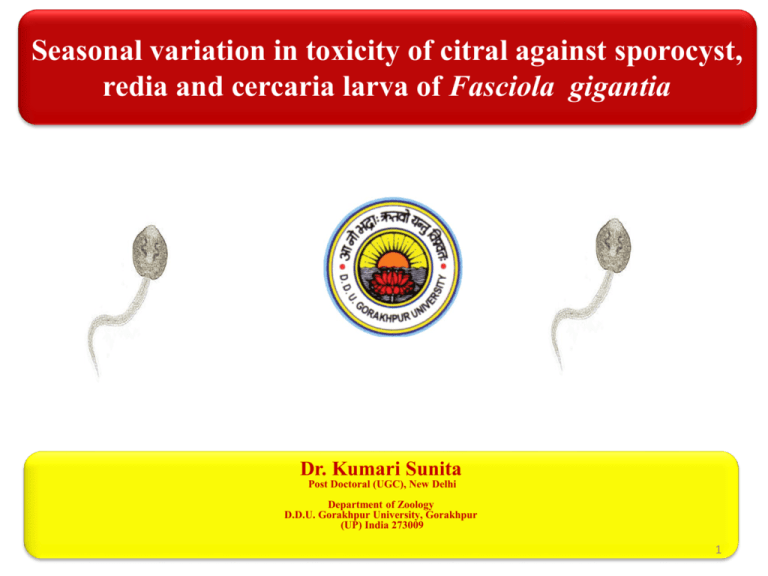
Seasonal variation in toxicity of citral against sporocyst, redia and cercaria larva of Fasciola gigantia Dr. Kumari Sunita Post Doctoral (UGC), New Delhi Department of Zoology D.D.U. Gorakhpur University, Gorakhpur (UP) India 273009 1 Fasciolosis is the vector- born parasitic disease showing the greatest latitudinal, longitudinal and altitudinal distribution know. It is caused by two trematode parasite Fasciola hepatica and Fasciola gigantica found in Asia and Africa. Fasciolosis has significant impact on growth, development and productivity in domestic ruminants. The freshwater snail L. acuminata is an intermediate host of the F. gigantica in northern parts of the India. According to WHO 2.4 million humans are infected with Fasciola and a further 180 million are at risk of infection. 2 Release of molluscicide in aquatic system for their control to kill the snails also affect the other non target organism. One way to reduce the incidence of fasciolosis is to destroy the life cycle of Fasciola larval by in vivo and in vitro phytotherapy of host snail L. acuminata at sublethal dose of molluscicide. It is a new approach to reduce the incidence of the fasciolosis without killing the snails The use of plant product (Citral) Zingiber officinale are effective, less expensive and eco-friendly. 3 Life cycle of Fasciola gigantica Primary host (Definitive host) • • • • Sheep Cattle Other Mammals Humans Humans (Accidental) Intermediate host Lymnaea acuminata Geographic Range • Cosmopolitan; anywhere sheep and cattle are raised 4 Cercaria larva from Secondary Host Lymnaea acuminata Lymnaea acuminata Immerging cercaria Cercaria larva 5 Adult Fasciola gigantica from Buffalo Liver Fasciola in Liver Adult Fasciola gigantica 6 OBJECTIVEs The objective of the present study is to explore the use of plant derived larvicidal component against different larval stages (sporocyst, redia, cercaria) found in the intermediate host snail Lymnaea acuminata. 1. Snails from different ponds in adjoining area were collected and acclimatized to laboratory condition. There after, they were dissected out under the microscope to observe the different larvicidal stage in snail body. 2. Infected snails were divided in two parts. One part were counted for larval infection without treatment (control) and second part was treated with different concentration (less than the ten times than LC50 value reported of snails) of Zingiber officinale and it active components respectively. Now these treated snails were dissected out after 2h, 4h, 6h, and 8h and number of dead and live larva were counted each month of the year. 7 3. In vitro treatment of plant derived molluscicides were studied against different larval stage in water number of dead and live larva will be counted in each month of the year. 4. On the basis of mortality data against different larvae LC50, g value, heterogeneity factor, t- ratio and slope value were calculated by the POLO computer programme of Robertson et al (2007) (Bioassay with arthropods POLO computer programme for analysis of bioassay data 2nd Edition 1-224). 5. Effective concentration for killing different larval stage (sporocyst, redia, cercaria) were suggested without killing the snails. 8 Methodology 1.Toxicity study was done by the method of Singh and Agarwal (1984).(J.Nat. Prod.47,702-705) 2. LC50, g value, Heterogeneity factor, slope, t-ratio was done by the method of Robertson et al (2007, pp1-224) Bioassay with arthropods POLO computer programme for analysis of bioassay data 2nd Edition 1-224 3. Product moment/ Rank correlation coefficient was done by the method of Sokal and Rohlf (1973) (Introduction to Biostatistics,freeman,W.H San Francisco). 9 Results LC50 mg/ml Sporocyst 90 80 70 60 50 40 30 20 10 0 2h 4h 6h 8h March April May Jun July Aug Sept Oct Nov Dec Jan Feb MONTHS Figure.1. In vitro toxicity (LC50 mg/ml) of citral against sporocyst larva in different months of year 2011-2012. 60 Redia LC50 mg/ml 50 40 2h 30 4h 20 6h 10 8h 0 March April May Jun July Aug Sept Oct Nov Dec Jan Feb MONTHS Figure.2. In vitro toxicity (LC50 mg/ml) of citral against redia larva in different months of year 10 2011-2012. LC50 mg/ml Cercaria 50 45 40 35 30 25 20 15 10 5 0 2h 4h 6h 8h March April May Jun July Aug Sept Oct Nov Dec Jan Feb MONTHS LC50 mg/L Figure.3. In vitro toxicity (LC50 mg/ml) of citral against cercaria larva in different months of year 2011-2012. 100 90 80 70 60 50 40 30 20 10 0 40 Sporocyst 35 30 25 March April May Jun July Aug Sept Oct Nov Dec Jan Feb 2h 4h 20 6h 15 8h 10 Temp 5 pH 0 DO CO2 MONTHS Figure.4. In vivo toxicity (LC50 mg/L) of citral against sporocyst and abiotic factors in different 11 months of year 2011-2012. Redia LC50 mg/L 80 40 70 35 60 30 50 25 40 20 6h 30 15 8h 20 10 Temp 10 5 pH 0 DO 0 March April May Jun July Aug Sept Oct Nov Dec Jan 2h 4h Feb CO2 MONTHS Figure.5. In vivo toxicity (LC50 mg/L) of citral against redia and abiotic factors in different months of year 2011-2012. Cercaria 70 40 35 60 LC50 mg/L 50 40 30 30 2h 25 4h 20 6h 15 20 10 10 5 0 0 Mach April May June July Aug Sept Oct Nov Dec Jan Feb 8h Temp pH DO CO2 MONTHS Figure.6. In vivo toxicity (LC50 mg/L) of citral against cercaria and abiotic factors in different 12 months of year 2011-2012. Larvae In vitro toxicity of citral Mar Apr May June July Aug Sept Oct Nov Dec Jan Feb Nov Dec Jan Feb Sporocyst Redia Cercaria Highest toxicity of Citral Lowest toxicity of Citral Larvae In vivo toxicity of citral Mar Apr May June July Aug Sept Oct Sporocyst Redia Cercaria 13 Findings In vitro and in vivo larvicidal activity of citral against the sporocyst, redia and cercaria larvae of F. gigantica in different months of year 2011-2012 is time and concentration dependent. In vitro highest toxicity of citral against cercaria (8h LC50-0.006 mg/ml)/sporocyst (8h LC50-8.55 mg/ml) was observed in the month of July and August. Lowest toxicity was noted in month of January (10.12 mg/ml)/November (15.49 mg/ml), respectively. In in vivo 8h LC50 of citral against redia/cercaria and sporocyst larvae in month of August and July (8h LC50-4.20 mg/L, 3.27 mg/L) was (8h LC501.23 mg/L), respectively. The lowest mortality was observed in between January-February. 14 Thank You 15
